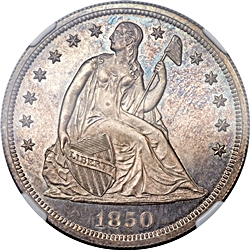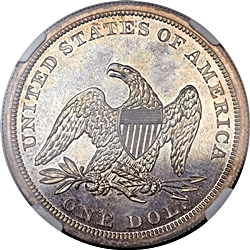 |
1850 
 |
 |
General CommentsFinding a problem-free coin in the XF45 Ė MS60 grade range is just a matter of patience. Theyíre available and come up reasonably often at auctions and on the bourse floor. In the lower grade ranges both patience and luck may be required. Problem-free coins below VF are simply not available. PCGS has slabbed a total of 11 coins below VF20. NGC has slabbed only a single F15. The finest known business strikes are MS64, two graded by PCGS, three by NGC, and two by CACG. A total of 17 coins have received a MS63 grade, 10 at PCGS, including 2 designated MS63+, 7 at NGC, and 5 at CACG. A total of 17 coins have been graded MS62. A total of 79 coins have received a mint state grade from one of the major grading services. Several of these grading records almost surely represent re-submissions. I also suspect that most of the coins that have been recently regraded by CACG havenít been removed from their previous PCGS or NGC population report. Business strike population statistics are as of August, 2024. The finest known proofs are four PR66 examples, one graded by PCGS, three by NGC. Two of the NGC coins are designated as Cameo. One additional coin has received a PR65 evaluation by NGC. A total of 16 coins have received a PR64 grade, including one PR64+ graded by PCGS. Current population reports (as of August, 2024) show a total of 31 proofs. A significant number of these grading records almost certainly represent re-submissions. I estimate that only 20 proofs exist in all levels of preservation. |
| |||||||||||||||||||||
1850 Proofs
1850 proofs merit a separate discussion. Estimates in the current literature of the original mintage, restrike mintage, and surviving population vary widely, as do opinions on what coins represent originals and what coins represent restrikes. Dave Bowers estimated the proof mintage as 40-60. I believe that this estimate is high. Iíve reviewed all coins sold by Heritage since 2002. I found a total of 13 sales. These represented 9 different coins. I believe that this supports an original mintage of around 35 coins, and a surviving population of 20. Most authors have assumed that some restrikes exist. If this is true it might support a higher mintage estimate. I question whether this date was restruck. Iíll discuss this more in the following paragraphs as I review the known die marriages.
All proof examples that I could confirm, either by direct examination or from pictures, have been struck from the same pair of dies. They pair the obverse die that was later used to create 1850 business strikes with Reverse 1840 PA, the die used to mint almost all original proofs beginning in 1840 and continuing through 1854. As Iíve stated before I believe that all coins that used this reverse die are original proofs. Confirmation of this comes from the fact that several 1850 proofs which Iíve personally examined have an obverse die thatís in a state earlier than that exhibited by the business strikes. Thus, they were minted prior to the 1850 business strikes. A possible issue comes from the information documented by Breen (reference 7). He states that a few of the proofs from this die marriage exhibit a light to heavy die crack through the base of the date, some with heavy knife rims. He believes that these are restrikes since they were minted after the business strikes. Weíve seen one of the coins that exhibits heavy knife rims, but have been unable to examine an example with the die crack. The example with the knife rims has an obverse die state later than the early business strikes, meaning that this and possibly other proofs may have been struck later in the year. However, in keeping with my theory of the usage of Reverse 1840 PA, I believe that these coins would have been minted late in 1850 and are thus NOT restrikes.
Both Breen and Bowers have mentioned a second proof die pair. This marriage paired a different obverse die, one exhibiting NO repunching on the date, with Reverse 1848 A, used to strike 1850 business strikes. The coin mentioned by both authors as an example of this die pairing is one that was part of the Byron Reed collection, now owned by the city of Omaha, Nebraska. The collection is now at the Durham Museum in Omaha. I was never able to personally examine this coin. Recent correspondence with museum representatives (reference 27) revealed that the coin was sold in 1996. The museum provided me with a copy of the auction lot description. It described a coin with a repunched date, meaning that this was a prooflike business strike, and was mis-described in the Breen reference (reference 7), and subsequently by Dave Bowers (reference 4) who cited the Breen reference in his description. I included the die pairing described by Breen and Bowers in my 1st Edition but have deleted it from this update to recognize the new information provided by the Museum.
Some literature has also suggested that proofs were coined from the business strike die pair. I believe that any such coins would be very early business strikes, still exhibiting the proof surfaces that would have resulted from the obverse die being first used to strike proofs.
Further support for the conclusion that all 1850 proofs are originals comes from my analysis of the proof restrikes of 1851, 1852, 1854, and 1858. With one exception (1854 OC-P3) all these restrikes paired the obverse dies with one of three reverses that were first used in later years Ė Reverse 1856 PA, Reverse 1859 PA, and Reverse 1865 PA. None of these reverse dies have been found on proof dollars dated 1850. This makes it unlikely that any 1850 proofs were created at the same time as the other restrikes.
In summary, I believe that all 1850 proofs are originals, and that only a single die pair exists, pairing the obverse die that was also used for business strikes with the reverse used for almost all proofs minted from 1840 through 1854.
1850 Die Marriages
Iíve identified a total of 2 die marriages for 1850, one proof and one business strike. The following table summarizes the known die marriages:
Click the links below to view the details of each die marriage.
Die Marriage |
Rarity |
Obverse Die |
Reverse Die |
Estimated Survivors |
| OC-1 | R3- | P1 | 1848 A | 400 |
| OC-P1 | R6 | P1 | 1840 PA | 20 |
A single pair of dies was used to strike all business strikes. Iíve identified this die marriage as OC-1. The obverse die shows strong repunching under the 0. Note that Breen identified two varieties, the
Prior to the striking of the business strikes, Obverse P1 was also used to strike proofs, paired with the common proof reverse used from 1840 through 1854. In the proof die pairing the die exhibits light die polish marks that are seen on some but not all the business strikes. The fact that these polish marks were gone for at least some of the business strikes makes it clear that the proofs were created prior to the business strikes. Since the obverse was first used to strike proofs, Iíve identified the die as P1, and the proof die pair as OC-P1.
Note that the 1st Edition of this reference described a second proof die marriage, with an obverse die that exhibited no repunching on the date. The existence of this die pairing has since been refuted by the information described in the previous section on 1850 proofs (reference 27).
1850 Business Strike Emission Sequence
With only a single die marriage the emission sequence isn't terribly interesting.
Emission Order |
Die Marriage |
Comments |
| 1 | OC-1 |
1850 Proof Emission Sequence
The proof emission sequence is just as exciting as that of the business strikes.
Emission Order |
Die Marriage |
Comments |
| 1 | OC-P1 |
1850 Quick Finder Chart
With only one obverse and two reverse dies for the year, and major markers on each, attribution is very easy.
Click the links below to view the details of each die marriage.
Die Marriage |
Obv. Die |
Rev. Die |
Right Base |
Keys to Identification |
| OC-1 | P1 | 1848 A | C | Obverse: Repunching on 0, visible on the lower left side of the prominent digit.
Reverse: A heavy die line slants down to the right through the horizontal shield lines at the right side of the shield. |
| OC-P1 | P1 | 1840 PA | C | Obverse: Repunching on 0, visible on the lower left side of the prominent digit.
Reverse: Defects inside upper part of A3. |
| Photo credits:
Obverse and reverse full photos: NGC PR66, from the Heritage archives. |
